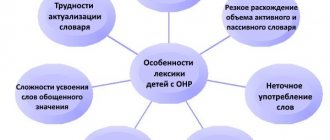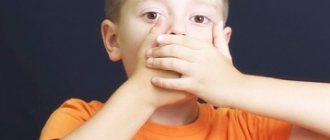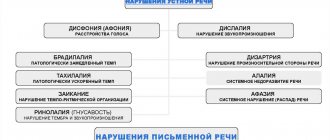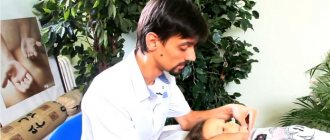Article:
Speech is the most important mental function inherent only to humans. Speech is the main communicative function, which is carried out through one language or another. On the basis of speech and its semantic unit of words , such mental processes as perception, imagination and memory are formed and developed.
L. S. Vygotsky pointed out that speech is a fundamental factor for the development of thinking and the formation of the “I”. In cases where a child has preserved hearing and is not impaired in intelligence, but there are significant speech impairments that cannot but affect the formation of his entire psyche, we are talking about a special category of abnormal children - children with speech impairments.
Speech disorders to one degree or another (depending on the nature of the speech disorders) negatively affect the entire mental development of the child and affect his activities and behavior. Severe speech disorders can affect mental development, especially the formation of higher levels of cognitive activity, which is due to the close relationship between speech and thinking and the limited social, in particular speech, contacts, during which the child learns about the surrounding reality.
Speech disorders and limited verbal communication can negatively affect the formation of a child’s personality, cause mental layers, specific features of the emotional-volitional sphere, and contribute to the development of negative character traits (shyness, indecisiveness, isolation, negativism, feelings of inferiority).
Speech therapy deals with the study, prevention and correction of speech disorders.
Speech therapy as a science
Speech therapy is the science of speech disorders, methods of identifying, eliminating and preventing them by means of correctional training and education. It is one of the branches of defectology. The term is derived from the Greek logos (word, speech), peideo (educate, teach) - translated as “education of speech.”
Currently, there has been significant progress in the development of speech therapy. Based on psychological analysis, important data were obtained on the mechanisms of the most complex forms of speech pathology (aphasia, alalia and general speech underdevelopment, dysarthria). Speech disorders are studied in complicated defects: in mental retardation, in children with visual, hearing, and musculoskeletal impairments. Modern neurophysiological and neuropsychological research methods are being introduced into speech therapy practice. The relationship between speech therapy and clinical medicine, child neuropathology and psychiatry is expanding.
Speech therapy at an early age is developing intensively: the features of pre-speech development of children with organic damage to the central nervous system are being studied, criteria for early diagnosis and prognosis of speech disorders are being determined, techniques and methods of preventive (preventing the development of a defect) speech therapy are being developed. All these areas of research have significantly increased the effectiveness of speech therapy work.
Due to the fact that correct speech is one of the most important prerequisites for the further full development of the child and the process of social adaptation, the identification and elimination of speech disorders must be carried out at an earlier date. The effectiveness of eliminating speech disorders is determined largely by the level of development of speech therapy as a science.
The subject of speech therapy as a science is speech disorders and the process of training and education of persons with speech disorders. The object of study is a speech disorder in a specific subject.
The structure of modern speech therapy consists of preschool, school speech therapy and speech therapy for adolescents and adults. The fundamentals of preschool speech therapy as a pedagogical science were developed by R. E. Levina and are based on the teachings of L. S. Vygotsky, A. R. Luria, A. A. Leontiev.
The main goal of speech therapy is to develop a scientifically based system of training, education and re-education of people with speech disorders, as well as the prevention of speech disorders.
Domestic speech therapy creates the most favorable conditions for the personality development of children with speech disorders. The successes of domestic speech therapy are based on numerous modern studies by domestic and foreign authors, indicating the great compensatory capabilities of the developing children's brain and the improvement of ways and methods of speech therapy correction. I.P. Pavlov, emphasizing the extreme plasticity of the central nervous system and its unlimited compensatory capabilities, wrote: “Nothing remains motionless, inflexible, but can always be achieved, changed for the better, as long as the appropriate conditions are met.”
Based on the definition of speech therapy as a science, the following tasks can be distinguished:
study of the ontogenesis of speech activity in various forms of speech disorders;
determination of the prevalence, symptoms and severity of speech disorders.
identifying the dynamics of spontaneous and directed development of children with speech disorders, as well as the nature of the influence of speech disorders on the formation of their personality, on mental development, on the implementation of various types of behavioral activities.
study of the characteristics of speech formation and speech disorders in children with various developmental disabilities (with impairments of intelligence, hearing, vision and the musculoskeletal system).
clarification of the etiology, mechanisms, structure and symptoms of speech disorders.
development of methods for pedagogical diagnosis of speech disorders.
systematization of speech disorders.
development of principles, differentiated methods and means of eliminating speech disorders.
improvement of methods for preventing speech disorders.
development of issues related to the organization of speech therapy assistance.
These tasks define both the theoretical and practical orientation of speech therapy.
The theoretical aspect is the study of speech disorders and the development of scientifically based methods for their prevention, identification and overcoming.
The practical aspect is prevention, identification and elimination of speech disorders. The theoretical and practical tasks of speech therapy are closely related.
To solve the tasks it is necessary:
ensuring the relationship between theory and practice, connection between scientific and practical institutions for faster implementation of the latest scientific achievements into practice;
implementation of the principle of early detection and overcoming speech disorders;
dissemination of speech therapy knowledge among the population for the prevention of speech disorders.
The solution to these problems determines the course of speech therapy intervention. The main focus of speech therapy is speech development, correction and prevention of speech disorders. In the process of speech therapy work, the development of sensory functions is provided; development of motor skills, especially speech motor skills; development of cognitive activity, primarily thinking, memory processes, attention; formation of the child’s personality with simultaneous regulation and correction of social relationships; impact on the social environment.
Speech therapy uses knowledge of general anatomy and physiology, neurophysiology about the mechanisms of speech, the cerebral organization of the speech process, the structure and functioning of analyzers that take part in speech activity.
Speech is a complex functional system, which is based on the use of the sign system of language in the process of communication. The most complex system of language is the product of long-term socio-historical development and is acquired by the child in a relatively short time.
The speech functional system is based on the activity of many brain structures of the brain, each of which performs a specific operation of speech activity. A.R. Luria identifies 3 functional blocks in brain activity.
The first block includes subcortical formations (formations of the upper trunk and limbic region) and ensures normal tone of the cortex and its wakeful state.
The second block includes the cortex of the posterior sections of the cerebral hemispheres, receives, processes and stores sensory information received from the external world, and is the main apparatus of the brain that carries out cognitive (gnostic) processes. Its structure includes primary, secondary and tertiary zones.
The third block includes the cortex of the anterior sections of the cerebral hemispheres (motor, premotor and prefrontal areas), provides programming, regulation and control of human behavior, regulates the activity of subcortical formations, regulates the tone and wakefulness of the entire system in accordance with the assigned tasks of activity.
Speech activity is carried out by the joint work of all blocks. At the same time, each block takes a certain, specific part in the speech process.
In the process of written speech, various parts of the occipital and parieto-occipital regions of the cerebral cortex also take part.
Thus, different areas of the brain are involved in the speech process in different ways. Damage to any part of it leads to specific symptoms of speech disorders. Data on the cerebral organization of the speech process make it possible to clarify ideas about the etiology and mechanisms of speech disorders. These data are especially necessary for the differential diagnosis of various forms of the disorder (aphasia) with local brain lesions, which makes it possible to more effectively carry out speech therapy work to restore speech in patients.
The organization of the speech therapy process makes it possible to eliminate or mitigate both speech and psychological disorders, contributing to the achievement of the main goal of pedagogical influence - human upbringing. Speech therapy intervention should be aimed at both external and internal factors causing speech impairment. It is a complex pedagogical process aimed primarily at the correction and compensation of speech impairments.
Theoretical foundations of speech therapy. Principles and methods.
Speech therapy is based on the following basic principles: systematicity, complexity, development principle, consideration of speech disorders in connection with other aspects of the child’s mental development, activity approach, ontogenetic principle, principle of taking into account etiology and mechanisms (etiopathogenetic principle), principle of taking into account the symptoms of disorders and the structure of speech defects , the principle of a workaround, general didactic and other principles.
The methods of speech therapy as a science can be divided into several groups.
The first group is organizational methods: comparative, longitudinal (study over time), complex.
The second group consists of empirical methods: observational (observation), experimental (laboratory, natural, formative or psychological-pedagogical experiment), psychodiagnostic (tests, standardized and projective, questionnaires, conversations, interviews), praximetric examples of activity analysis, including speech activities, biographical (collection and analysis of anamnestic data).
The third group includes quantitative (mathematical-statistical) and qualitative analysis of the data obtained; machine data processing using a computer is used.
The fourth group is interpretive methods, methods of theoretical study of connections between the phenomena being studied (the connection between parts and the whole, between individual parameters and the phenomenon as a whole, between functions and personality, etc.).
Technical means are widely used to ensure the objectivity of the study: intonographs, spectographs, nasometers, video speech, phonographs, spirometers and other equipment, as well as X-ray cine photography, glottography, cinematography, electromyography, which make it possible to study the dynamics of integral speech activity and its individual components.
It is important in speech therapy to distinguish between the concepts of normal and speech disorders. The norm of speech refers to the generally accepted options for using language in the process of speech activity. With normal speech activity, the psychophysiological mechanisms of speech are preserved. A speech disorder is defined as a deviation in the speaker’s speech from the language norm accepted in a given language environment, caused by a disorder in the normal functioning of the psychophysiological mechanisms of speech activity. From the point of view of communication theory, speech disorder is a violation of verbal communication. The relationships that objectively exist between the individual and society and are manifested in verbal communication are upset.
Speech disorders are characterized by the following features:
they do not correspond to the age of the speaker;
are not dialecticisms, illiteracy of speech and an expression of ignorance of the language;
are associated with deviations in the functioning of the psychophysiological mechanisms of speech;
often have a negative impact on the further mental development of the child;
are sustainable and do not disappear on their own;
require a certain speech therapy intervention depending on their nature.
This characteristic makes it possible to differentiate speech disorders from age-related characteristics of speech, from its temporary disturbances in children and adults, from speech characteristics caused by territorial dialect and sociocultural factors.
The terms “speech disorder”, “speech defects”, “speech deficiencies”, “speech pathology”, “speech deviations” are also used to denote speech disorders. A distinction is made between the concepts of “speech underdevelopment” and “speech impairment”.
Underdevelopment of speech implies a qualitatively lower level of formation of a particular speech function or the speech system as a whole.
A speech disorder is a disorder, a deviation from the norm in the process of functioning of the mechanisms of speech activity. For example, with underdevelopment of the grammatical structure of speech, a lower level of assimilation of the morphological system of the language and the syntactic structure of the sentence is observed. Violation of the grammatical structure of speech is characterized by its abnormal formation and the presence of agrammatisms.
In psychology, there are two forms of speech:
a) external (written and oral (dialogue, monologue);
b) internal .
Dialogical speech is the psychologically simplest and most natural form of speech; it occurs during direct communication between two or more interlocutors and consists mainly of exchanges of remarks.
Monologue speech is a consistent, coherent presentation by one person of a system of knowledge. Three types: narrative; description; reasoning.
With speech defects, monologue speech is impaired to a greater extent than dialogic speech.
Written speech is graphically designed speech, organized on the basis of letter images. The full assimilation of writing and written speech is closely related to the level of development of oral speech. During the period of mastering oral speech, a preschool child unconsciously processes language material, accumulates sound and morphological generalizations, which create readiness to master writing at school age.
Internal form of speech : (speech to oneself) - silent speech that occurs when a person thinks about something, mentally makes plans. It is formed in a child on the basis of external factors and represents one of the mechanisms of thinking. The transfer of external speech into internal speech is observed in a child at the age of about three years, when he begins to reason aloud and plan his actions in speech. Gradually, such pronunciation is reduced and begins to take place in inner speech.
The development of a child’s speech can be presented in several aspects related to the gradual acquisition of language:
development of phonemic hearing and formation of skills in pronouncing phonemes of different languages;
mastery of vocabulary and syntax rules. Active mastery of mechanical and grammatical patterns begins in a child at two to three years old and ends by seven. At school age, acquired skills are improved based on written speech;
mastery of the semantic side of speech. It is most pronounced during schooling.
In the psychological development of a child, speech is of enormous importance and performs communicative, generalizing and regulatory functions.
A lack of speech development should be understood as a deviation from the normal formation of linguistic means of communication. Changes in speech (considered in speech therapy) should be distinguished from age-related features of its formation. This or that difficulty in using speech can be considered as a disadvantage only taking into account age norms.
Speech therapists determine the following stages of child speech development from birth to six years:
At 2 months of life, humming and croaking (b, p, m, k, d, x) of reflex origin begins to appear, independent of the child’s will.
3 – 4 months the character of the noise changes. It acquires different intonations and gradually begins to turn into babbling.
5th month - unconscious repetition of sounds after others.
6th month - repetition of individual syllables begins, gradually they are fixed in the child’s memory.
Up to 1 – 1.5 the period of preparation of the child for speech takes place. Communication occurs mainly through facial expressions, gestures, and “own words.”
From the age of 2 years, the discrimination of all sounds of speech communication begins.
By the age of 3–4 years, the child begins to realize his mistakes and shortcomings in comparison with the speech of others. Drawbacks are possible (loudness, individual sounds, replacement of sounds with simpler ones, etc.).
By the age of 5–6 years, the child masters normal pronunciation.
Knowledge of the anatomical and physiological mechanisms of speech, i.e. the structure and functional organization of speech activity allows:
firstly, to imagine the complex mechanism of speech in normal conditions;
secondly, take a differentiated approach to speech pathology;
thirdly, to correctly determine the paths of corrective action.
We have already found out that speech is one of the complex higher mental functions of a person. In order for a person’s speech to be articulate and understandable, the movements of the speech organs must be natural and accurate and at the same time automatic.
The structure of the speech apparatus
The speech apparatus consists of two closely interconnected parts: the central (or regulatory) speech apparatus and the peripheral (or executive).
Central speech apparatus : located in the brain. It consists of the cerebral cortex (mainly the left hemisphere), subcortical ganglia, pathways, brainstem nuclei (primarily the medulla oblongata) and nerves going to the respiratory, vocal and articular muscles.
Speech, like other manifestations of nervous activity, develops on the basis of reflexes. Speech reflexes are associated with the activity of various parts of the brain. Some parts of the cerebral cortex have a dominant position in the formation of speech:
frontal (gyri) are the motor area and are involved in the formation of speech abilities (Broca's area).
The temporal gyri (superior) are the speech-auditory area where sound stimuli arrive (Wernicke's center) and the process of perceiving someone else's speech occurs.
Parietal lobe of the brain - responsible for understanding speech.
Occipital – visual area and ensures the assimilation of written speech (perception of letter images when reading and writing).
The subcortical nuclei control rhythm, tempo and expressiveness.
The peripheral speech apparatus has 3 sections:
Respiratory (chest with lungs, bronchi and trachea).
Vocal (the larynx with the vocal folds located in it is a wide short laryngeal tube consisting of cartilage and soft tissue.) From above, the larynx passes into the pharynx, from below into the windpipe (trachea). At the border of the larynx and pharynx is the epiglottis (cartilaginous tissue and has the shape of a tongue or petal). The anterior surface faces the tongue, the posterior surface faces the larynx. The epiglottis is like a valve that closes the entrance to the larynx and protects its cavity from food and saliva.
In men, the larynx is larger, and the vocal folds are longer and thicker (from 20 to 24 mm). In women, the length of the vocal folds is approximately 18 – 20 mm.
In children, the larynx is small and grows unevenly. Noticeable growth at 5–7 years, and then during puberty. In girls aged 12–13 years, the volume of the larynx increases by 1/3; in boys aged 13–15 years, by 2/3, designated the Adam's apple.
When whispering, the vocal folds do not close completely; a gap remains in the back.
Articulatory (tongue, lips, jaws (upper and lower), hard and soft palate, alveoli). The tongue, lips, soft palate and lower jaw are movable, the rest are immobile.
Causes of speech disorders
external (exogenous) factors;
internal (endogenous) factors;
external environmental conditions.
Various intrauterine pathologies (the most severe speech defects occur between four weeks and four months) - toxicosis, viral and endocrine diseases, injuries, Rh factor incompatibility, etc.
Birth trauma and asphyxia (lack of oxygen supply to the brain due to breathing problems)
Diseases in the first years of life (especially harmful: infectious viral diseases, meningo-encephalitis and early gastrointestinal disorders).
4) Skull injuries accompanied by concussion.
Hereditary factors (only part of the general disorder of the nervous system and combined with intellectual and motor impairment).
Unfavorable social and living conditions leading to microsocial pedagogical neglect, autonomic dysfunction, disorders of the emotional and volitional sphere and a defect in speech development.
Classification of speech disorders
Throughout the history of the development of speech therapy, researchers have strived to create a classification of speech disorders that covers all their diversity. But even now, the problem of classification remains one of the most pressing not only for speech therapy, but also for other scientific disciplines that study speech disorders. The complexity of the classification of speech disorders is due to a number of reasons, among which the leading place is occupied by insufficient knowledge of the mechanism of speech itself, as well as the discrepancy in the views of researchers on the issue of the principles on the basis of which it should be built.
Thus, there are currently two classifications of speech disorders in circulation in domestic speech therapy:
Clinical and pedagogical;
Psychological and pedagogical (pedagogical) (according to R.E.Levina).
The clinical and pedagogical classification is based on the traditional collaboration between speech therapy and medicine, but, unlike the purely clinical classification, the types of speech disorders identified in it are not strictly tied to the forms of the disease. It is focused mainly on the correction of speech defects, on the development of a differentiated approach to overcoming them and is aimed at the utmost detail of the types and forms of speech disorders, therefore it is based on a deductive approach (from general to specific).
Based on the needs of speech therapy intervention, the following criteria are identified that make it possible to imagine what is impaired in speech, and on this basis to distinguish one speech disorder from another based on delimitation: 1) violations of the form of speech (oral or written); 2) impaired type of speech activity in relation to each of the forms: for oral – impaired speaking or listening, for written – writing or reading; 3) a disrupted stage (link) of speech generation or perception: in relation to productive types of speech activity (speaking and writing). It is essential to distinguish between violations associated with the stages of internal or external formulation of the statement. 4) violation of operations that carry out the formalization of an utterance at one or another stage of the process of generation or speech perception; 5) impaired means of formalizing statements.
Each of the selected criteria when describing one or another speech disorder can be presented more differentiated, which will make it possible to detect subtypes in individual types that are important for speech therapy. By supplementing the picture of a particular disorder, it is possible to differentiate defects with similar external manifestations based on the following data: 1) what factors cause the speech disorder (social or biological); 2) against what background it develops (organic or functional); 3) in what part of the speech functional system is it localized (central or peripheral); 4) what is the depth (degree) of disturbance of the central or peripheral speech apparatus; 5) the time of its occurrence.
Myth three. A good specialist will fix everything
There are violations that cannot be completely corrected. And they will persist throughout your life. This, for example, is dysarthria or stuttering - a violation of the tempo-rhythmic organization of speech, caused by a convulsive state of the muscles of the speech apparatus.
To solve the problem, in addition to speech therapy sessions, the child is seen by a neurologist, who can prescribe drug therapy, physical therapy, massage of the cervical-collar area, and speech therapy massage.
But it is not always possible to correct a defeat.
In class, a child can speak well, but as soon as he loses control of himself, for example, during a walk, a normal conversation with parents, in a stressful situation (at a matinee in kindergarten, at the blackboard at school), then his speech often becomes incomprehensible.
It is also difficult to correct motor and sensory alalia. Alalia is a violation when a specialist cannot even predict how well it can be corrected. A speech therapist, together with other specialists, can bring a particular child to a certain level. But each child with alalia has his own level.
An experienced speech therapist can develop a child’s speech. Photo: logolandiya.ru
It all depends on when the child was diagnosed (this is done by a neurologist), at what age the work began, what individual characteristics the child has, how experienced the speech therapist who works with him is, how often the parents attend classes. The specificity of the disorder is associated with damage to the areas of the brain responsible for speech.
The concept of speech correction. Reasons for deviations
In speech therapy, correction is a set of techniques aimed at eliminating speech defects and mechanisms that led to the development of deviations. There are a large number of causes for the development of defects, which are classified into the following groups:
- postpartum;
- complications during childbirth;
- hereditary;
- congenital.
Functional causes also include psychosomatic, endocrine and environmental ones. This category includes pathologies caused by disorders of organs involved in speech. Speech therapy correction is aimed at correcting all of the above defects using various methods and techniques.
Myth fifth. There is no use in gardening
Parents love to compare a speech therapist in private practice and a speech therapist from a regular kindergarten, complaining that the latter is of zero use. But a speech therapist in private practice has more opportunities: he will work with the child without limiting himself by time or number of classes (of course, a lot depends on the financial component and the wishes of the parents). If conditions are created for a speech therapist in kindergarten, he will be able to work more effectively with children. But…
Class with a speech therapist in kindergarten. Photo: f21.ifotki.info
A speech therapist in a regular kindergarten needs to select those with whom he will work from the total number of children. The number of places and the number of children do not match: alas, there are always fewer places, but more children with speech impairments. The speech therapist in the garden keeps a huge amount of documentation.
A lesson for one child lasts only 20-30 minutes, there are two such lessons per week. Moreover, these 20 minutes also include the time when the speech therapist goes to the group and picks up/returns the child. The kid has just joined the lesson, and he already needs to be led back. And only on weekends the speech therapist gives parents a task: how and what to do at home with the child.
Parents often do not complete the assigned tasks: they don’t have time and don’t want to.
The child is sent to specialized (speech therapy) kindergartens and groups based on the conclusion of the psychological, medical and pedagogical commission. But it is difficult for the specialists on the commission to determine the real speech status of the child in five minutes. And a child who needs speech correction does not always end up in a speech group. Parents have only one option - contact a specialist for a fee. This raises the question: how to find a good speech therapist?
Tips from Olga Khalcheva
- You have the right to ask the speech therapist for documents about his education. It is important to ask a specialist how often he takes advanced training courses and whether he participates in seminars and scientific conferences. How does he do it: in person or online? Now, due to the coronavirus pandemic, classes have gone online, but you shouldn’t always trust distance learning. People watch the video, do not take any tests, but simply receive a document on advanced training. Some people don't even open the video for viewing.
- Ask the speech therapist if he takes supervision (observation from a more experienced colleague), who is his mentor? When a specialist works with children alone for many years, he may not notice some details. Now science and practice in the field of speech therapy are developing so much, and what was relevant 10-12 years is not always applicable now.
- If a parent doubts the conclusion of a speech therapist, they need to visit another specialist. Look for your own speech therapist; the classes should please not only the child, but also suit the parent.
- Every parent has the right to ask every specialist: when will the result be, what is the prognosis? If there is no prognosis or the result does not occur, you may need to change the specialist. But don’t forget that you yourself must actively study at home with your child in order to see results!
- Some parents of children in need of drug treatment often put off visiting a neurologist. For example, an electroencephalogram not done on time leads to difficulties in identifying concomitant disorders, to the inability of a neurologist to outline adequate treatment measures - all this slows down the work of a speech therapist. A speech therapist, wondering what correctional measure is suitable for a child, cannot work effectively. You can work with your child endlessly, but to no avail.
- Nowadays, everyone and every child loves to do speech therapy massage; it’s like a panacea for everything. Speech therapy massage can not only help, but also harm. Parents, attend classes! Ask about the manipulations that the speech therapist performs with your child. Ask: why does your child need this?
Physiotherapy in the field of speech impairment correction
Methods of physiotherapeutic treatment in the correction of speech disorders are aimed at improving blood circulation and stimulating the muscles of the articulatory apparatus in order to eliminate speech defects. This direction in speech therapy correction is based on the use of natural factors, therefore such techniques do not pose a danger to the human body.
Today, the following methods of physiotherapy are used in the treatment of speech disorders:
- chromotherapy (exposure to color);
- amplipulse therapy;
- magnetic therapy;
- electrophoresis;
- Biofeedback therapy.
Amplipulse therapy involves exposing vulnerable parts of the body to sinusoidal modulated currents. The procedure helps to strengthen the voice and increase the tone of the articulatory muscles.
Magnetotherapy is a direction in physiotherapy that uses magnetic fields for treatment. This effect makes it possible to achieve normalization of the processes of transmission of nerve impulses, improvement of blood circulation, as well as regulation of mental processes of excitation and inhibition.
Electrophoresis is a method of physiotherapy in which the body is simultaneously exposed to drugs and direct current. Electricity enhances the effects of medications that tone muscles and increase blood flow.
Biofeedback therapy uses a special complex, which consists of a hardware and software component. Exercises allow you to restore the correct physiology of speech breathing, improve blood circulation and normalize the activity of the nervous system.
Myth four. A parent can handle it himself!
Can parents cope with a speech therapy problem on their own? No! Parents often cannot even see the problem. At the beginning of my career as a speech therapist, a mother came to see me with a child who was diagnosed with a phonetic-phonemic speech disorder. I went with the child to the mentor and consulted. For a long time, the mother could not believe that her child spoke so poorly.
My mentor and I tried to prove to her that the child had a big problem with speech and that we urgently needed to work with him. But the mother objected: she understands the child and does not see the point in the classes. The classes never took place.
Parents almost always expect quick results.
On Vladimir forums, some mothers write that they studied with a speech therapist for two years, three months, and some child received sounds in 5 lessons. How is it possible that someone had a bad speech therapist?
The effectiveness depends not only on how good the speech therapist is, but how good the child and the parent are in conjunction. The disorders are different, the children are different, the frequency of attending classes is different, and the speech therapists themselves are again different. One more nuance: it’s one thing to correct two or three sounds, another thing to start speech. Parents often confuse the concepts of sound pronunciation correction and sound production.
A story about a girl. A mother brought a 4.5-year-old child with a significant delay in speech development to the appointment. The child even lacked some vowel sounds. Over the course of two lessons, we introduced the first sound and began to automate it into syllables. At the third lesson, my mother said that she was spending a lot of energy, she didn’t have time, and they stopped the classes.
Sound production is one of the stages of sound pronunciation correction. Many speech therapists say that they teach sounds in 6 lessons. Yes, you can make sounds in 3 lessons. But to introduce them into speech, longer work is needed.
Correction of sound pronunciation involves the propaedeutic stage (preparing the organs of articulation for sound production), the stage of sound production, the stage of sound automation (in syllables, words, sentences, stories, colloquial speech), sound differentiation (auditory, pronunciation, the formation of phonemic analysis and synthesis).
This format of work is correct, this is how a speech therapist should work when correcting sound pronunciation. Otherwise, the child will not be able to use the corrected sound in speech, and difficulties may arise in reading and writing.
Cost of speech therapist-defectologist services:
| Service | Cost, rub) |
| Initial paid appointment with a children's speech therapist (diagnosis and consultation) | 2 500 |
| One activity per child | 2,000 (40 min. - 1 hour) |
| Lesson in a dyad or mini-group | 1,800 (50 min.) |
| One lesson in combination with Forbrain | 2,400 (40 min.) |
A speech pathologist-defectologist provides paid services in each of the four departments of our Center in Moscow, prices are indicated above. Every day from 10-00 to 18-30.







